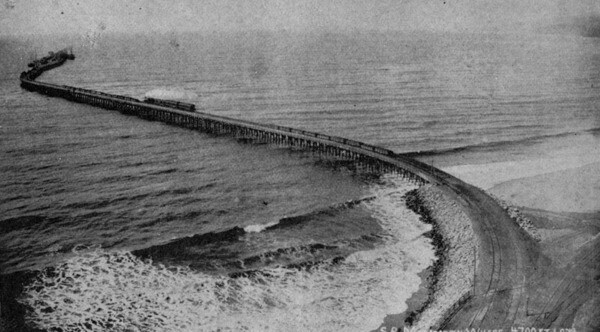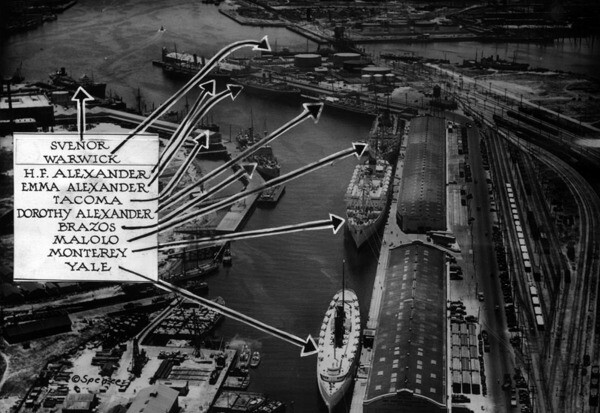Brief History of the Ports of Los Angeles and Long Beach


This is part of a series examining the 710 Corridor and its impact in the surrounding communities, produced in partnership with the California Endowment.
The Ports of Los Angeles (POLA) and Long Beach (POLB) have helped transform the City of Angels into the largest business investment in America. As a Mecca for international trade, Southern California is part of a $8.9 trillion global exchange that also facilitates a contemporary U.S. trade deficit with China, the largest trade deficit in world history. The POLA and POLB contemporaneously facilitate 14.1 million containers annually, earning the title as the fifth largest seaport in the world in 2005. These harbors are considerably ahead of the nation's second place New York/New Jersey ports, the world's seventeenth largest.
Although the Ports of L.A. and Long Beach are the economic one-two punch for the region, it comes at a great cost. The ports are part of the region's mobile sources that account for 94% of our ambient carcinogenic risk. The dual ports are the single largest fixed source of air pollution in the entire L.A. basin, and before recent improvements (after years of community uproar), they emitted as much diesel exhaust as 16,000 trucks running for 24-hours straight.
When Native Californians encountered Portuguese Juan Rodriguez Cabrillo in 1542, the port was a desolate marsh, more closely resembling a scene from "Jurassic Park" than the industrial scenes from "Gone in 60 Seconds." It was also shallow -- very shallow. Yet, Southern California didn't offer many other seaport selections, and it remained relevant during the Mission period, Mexican Independence, and the U.S. Mexican War.
Although many assisted with the port's rise, it was Phineas Banning who earned the title as the "Father of the Los Angeles Harbor" during the 1850s and '60s. Not only did he found the harbor city of Wilmington, Banning helped build a transportation system using stagecoaches, moving recently-arrived people and goods throughout the Southland. He even helped put a post office and newspaper in the harbor area.
During the Civil War, Banning made 60 acres of harbor territory available to Union forces. With thousands of troops at the recently christened Fort Drum, the port's presence grew. By 1869, the Los Angeles and San Pedro Railroad transported goods from the harbor and central L.A. It was the first railroad in Southern California.


The "Great Free-Harbor Fight" of the 1890s is also among the most defining events in harbor history. In what became years of political turmoil over keeping the POLA at San Pedro in lieu of Santa Monica, the City of Los Angeles' lobbying efforts to secure San Pedro had one major obstacle: they did not own the harbor. Their solution was a sixteen-mile "shoestring district," connecting the harbor via a narrow piece of land less than a mile wide from Los Angeles, allowing for annexation of the harbor. With the prospect of joining the booming city, San Pedro and Wilmington relinquished control to Los Angeles in 1909.
The opening of the Panama Canal in 1914 was integral to the growth of our harbors. Los Angeles' strategic position on America's West Coast meant that its harbor would quickly become the main ports o' call for Pacific and Atlantic trade; when the Ports of Long Beach was founded in 1911, it only solidified the dual seaports.
The POLA and POLB also greatly benefited from World War II rearmament. The U.S. Naval Shipyard was stationed at the POLB and considered the most modern facility in the nation. During the war years, ship and aircraft production in the Southern California area was a 24-hour, around the clock operation that manufactured some 15 million tons of war products. The San Pedro area became an integral part of the $70 billion in Federal wartime monies contracted to the Southern California region, where, by 1943, nearly 500,000 were employed in ship, plane, and steel production.
In 1958, aboard the Hawaiian Merchant, the Matson Navigation Company handled the first shipment of 20 containers in Southern California, what the POLA later considered the beginning of the "containerized cargo revolution." Containers proved much easier than moving bulky packages, drastically increasing the amount of goods moved throughout the ports and local corridors like the 710 Freeway. Longshoremen teams of up to eighteen men, moving ten tons an hour, could be reduced to only five men that moved 450 tons per hour. By the early 1980s, this resulted in a ship turnaround from eight to ten days to a mere 36 hours. These dramatic results were achieved because once unloaded by cranes, containers were simply placed atop truck chassis or trains, and motored to their destination. The POLA handled 7,000 containers by 1959; the POLB joined the container revolution a few years later.
Multiple trade agreements made sure the port was heavily utilized. The General Agreement on Tariffs and Trade initiated an international trade proliferation from $365 billion to $64 trillion by the year 2000 as tons of international cargo moved through the ports. In 1962 Los Angeles Mayor Sam Yorty headed a successful East-Asian trade mission that lead to additional trade agreements. By the mid 1970s, Los Angeles port authorities signed trade provisions with Hong Kong, Japan, and Taiwanese-based Evergreen Line Company. By 1981, China Ocean Shipping Co. inaugurated its first port of call in Long Beach.


The economic impacts were phenomenal, as were the ports' expansion efforts. From 1953-54, some 26.5 million tons moved through POLA facilities. In 1960, POLA launched a five-year, $37 million development project, to construct fifteen berths and five new cargo terminals; a second $14 million bond was issued two years later. POLA was the largest man-made harbor on earth and moved 24.5 million shipping tons in 1960. By 1966, more investment dollars were spent on the ports since World War II than any other in the nation, with the exception of New York.
Yet, port authorities presented a paradigm that encouraged more expansions. Even previously dredged sections needed to be made deeper. During the 1970s, POLA began a $36 million process that eventually dredged the port ten additional feet, and POLB began construction on what was the world's largest landfill expansion.
While the port's expansions efforts are prolific, the impact to the community has been less announced. The litany of "improvements" since the days of Banning have significant and permanent impacts to sea life and harbor residents, who essentially subsidize the ports with their health. If the boost to the economy is genuine, then so are the negative impacts.
For starters, the ports were once home to large scale fishing and packing industry, including Star-Kist Foods, the world's largest fish cannery. Port authorities were pleased with the millions in revenue the company earned, and residents were pleased with union paying jobs that went mostly to women of color. By 1929, some 75% of all California fish were canned in Los Angeles, generating tons of fish meals, oils, and other economic benefits. Thousands were employed by a hugely successful industry, until overfishing and port-related industrial pollution and expansion helped stifle aquatic life. Unions were also destroyed.
Port expansions also lead to a significant loss of community acreage for parks, schools, and important community facilities. Although some of that has been replaced (sometimes through lawsuit dollars), both ports equal some 10,500 acres, and plans continue for their expansion. Last year, POLB docked the world's largest container vessel, which can hold 12,500 containers and is as tall as the Empire State Building (first generation tankers held a mere 1,700). With fear of the Panama Canal taking away local pay checks, expansion efforts have boiled into a "beat the canal" campaign that wants to expedite environmental reviews in an effort to expand harbor territory further.


For decades, the most talked-about impact of the ports to the community has been health risks, specifically diesel exhaust. During a proposed 1970s LASH terminal, studies projected the handling of 320,000 tons per year with 100% of the cargo transported by 300,000 annual diesel truck movements. Even though diesel was known to be harmful (listed as a toxic air contaminant in 1998), with over 40 chemicals known to cause cancer, somehow environmental records predicted no adverse effects from 300,000 truck movements. Other environmental reports had the same sunny outlook and as a whole read: decades of dramatic increases in container and diesel trucks would have no negative cumulative impacts on community health.
In fact, ongoing expansion of the ports became so profuse that multiple agencies had significant concerns. The precursor to the Air Quality Management District became involved in POLB's expansions, and used language to describe their environmental review process as "misleading," "inaccurate," and critiqued one updated environmental report as "hardly an improvement" over a previous draft. Caltrans and the California Air Resources Board were also critical of port expansions.
The ports are also home to a diverse collection of industrial sites. Oil refineries, recycling centers, and industrial warehousing also call the harbor home. POLA was also home to several chemical companies, including one company that registered 53,193 tons of chemicals and "discharged" 42,963 tons of chemicals during the 1960-61 fiscal year.
The ports have also been host to significant accidents that pose dangers to workers and community members. In 1944, a massive explosion at POLA'S Berth 233 "brought into flaming reality... the many potential hazards of Los Angeles' busy wartime harbor," read the Fire Department's report. The explosion ignited local trucks, cars, and structures, killing about eleven persons. The 1947 explosion of the S.S. Markay enacted a force so powerful that the blast jolted buildings several miles away, damaging several buildings. Damages were approximately $2.5 million. An additional explosion of the Tanker Sansinena occurred in 1976, killing nine.
The dual ports not only service Southern California, but the entire country. They are important. So are the transportation corridors that service it, including the 710 Long Beach Freeway, the subject of our next story.